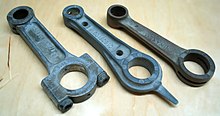
Back ذراع توصيل Arabic Sürgü qolu Azerbaijani Шатун Byelorussian Мотовилка (машинен елемент) Bulgarian སྦྲེལ་མདའ། Tibetan Biela Catalan قۆڵە بەگن CKB Ojnice Czech Plejlstang Danish Pleuel German


A connecting rod, also called a 'con rod',[1][2][3] is the part of a piston engine which connects the piston to the crankshaft. Together with the crank, the connecting rod converts the reciprocating motion of the piston into the rotation of the crankshaft.[4] The connecting rod is required to transmit the compressive and tensile forces from the piston. In its most common form, in an internal combustion engine, it allows pivoting on the piston end and rotation on the shaft end.
The predecessor to the connecting rod is a mechanic linkage used by water mills to convert rotating motion of the water wheel into reciprocating motion.[5]
The most common usage of connecting rods is in internal combustion engines or on steam engines.
- ^ "Connecting Rods and Bearings". Engine Builder Magazine. 25 October 2010. Retrieved 21 August 2022.
- ^ "Con rods link pistons and crankshaft | Perkins". www.perkins.com. Retrieved 21 August 2022.
- ^ "What is Con Rod?". accurateengg.com. 22 November 2019. Archived from the original on 5 February 2023. Retrieved 21 August 2022.
- ^ Yamagata, H. (2005). The Science and Technology of Materials in Automotive Engines. Woodhead Publishing in materials The science and technology of materials in automotive engines. Elsevier Science. p. 207. ISBN 978-1-84569-085-4.
- ^ Lyon, Robert L. Steam Automobile Vol. 13, No. 3. SACA.